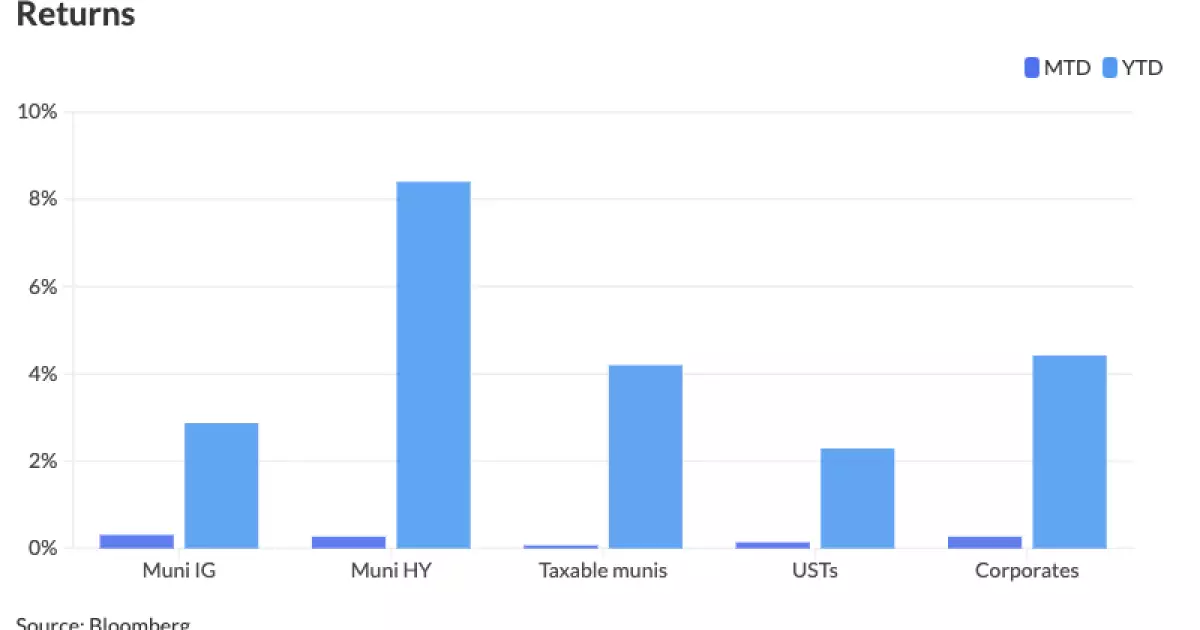The municipal bond market, a crucial segment of the U.S. fixed income landscape, has recently displayed noteworthy trends influenced by numerous economic and political factors. As we look into the specifics, it becomes clear how various elements interplay to shape market directions, especially amid turbulent conditions. This article critically analyzes the present state of the municipal bond market, examining the influences of new issuance, investor behavior, and economic indicators while highlighting future expectations.
On a recent Tuesday, the municipal market faced slight declines as investors processed a substantial wave of new bond issuances. Coupled with a softer U.S. Treasury market, municipal yields experienced a minor uptick of up to two basis points across various maturities. This reaction underscores a fundamental aspect of the bond market: that investor sentiment is significantly influenced by broader economic conditions and treasury yields. Notably, while U.S. Treasury yields increased by one to two basis points, municipal rates displayed a surprising resilience, suggesting that investors are maintaining a cautious optimism about municipal investments.
Furthermore, the ratios of municipal bonds to U.S. Treasuries signal changing dynamics in investor behavior. For instance, the two-year municipal to Treasury ratio stood at 61%, while the 30-year ratio was at an impressive 81%. These figures indicate a broader acceptance of municipal bonds relative to safer Treasury securities, hinting at a potential risk appetite among municipal investors.
Year-end scenarios in the municipal bond market are fueled by multiple factors, including seasonal reinvestment flows and supply-demand dynamics. Market analysts, such as Nuveen’s leadership, anticipate continued robust performance through early 2024, boosted by expected inflow surges around January 1. This outlook is substantial given the nearly $500 billion in new issuances over the calendar year. The resilience of munis, even amidst significant new supply, reflects an underlying strength in demand.
Additionally, technical factors lend credibility to ongoing bond market optimism. With a reported negative net supply of approximately $23 billion, this lack of available bonds may create a favorable environment for remaining issuances, offering support for prices and yields. Such a scenario instills confidence among investors, as stronger performance expectations compete with the traditional narrative of market fluctuations related to the presidential election cycle.
As outlined in the recent performance analytics, municipal bonds have rebounded significantly. Following a challenging October, where AAA municipal yields rose sharply, November saw a robust 1.73% increase, outperforming previous losses. Investors’ reactions are informed by both the Fed’s anticipated rate cuts and existing demand, creating a bullish sentiment. This attitude among investors highlights a shift towards seeking additional yield through municipal bonds, especially in the high-yield segment which has reaped significant gains this year.
Daryl Clements from AllianceBernstein emphasizes that strong technical tailwinds combined with an “insatiable demand” underpin the favorable trajectory anticipated for municipal bonds. With a notable influx of $42 billion into mutual funds and ETFs, the bond market appears to cater to a risk-tolerant investor base seeking sustainable returns in a low-yield environment.
In the primary market, new issuances also reflect the evolving landscape of municipal finance. Recently, significant transactions, including a $2.155 billion state sales tax revenue bond for the Dormitory Authority of New York and various refinancing efforts across municipalities, suggest that investors remain active and engaged. These strategic movements not only fulfill immediate financial needs but also indicate an outlook whereby municipalities are leveraging favorable market conditions to secure capital efficiently.
Looking ahead, analysts remain vigilant about prospective issuances and market forces that could pivot the present dynamics. The Federal Reserve’s impending decisions—particularly regarding potential rate cuts—play a crucial role in influencing investor confidence. With a predicted rate cut probability of 80% in the coming December meeting, the market is bracing for a scenario that could further propel municipal bond valuations, opening avenues for sustained growth and investor interest.
The municipal bond market stands at a potentially advantageous junction as year-end approaches. With resilient demand, a favorable technical picture, and supportive economic indicators, the asset class is likely to perform well over the coming months. Investors seem poised to capitalize on these conditions, reflecting an adaptive market willing to navigate uncertainty for higher yields. As the economy continues to evolve, monitoring these trends will be pivotal for stakeholders engaged in the municipal bond landscape.


Leave a Reply